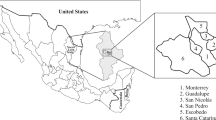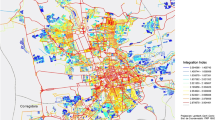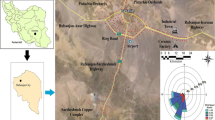Abstract
Street dust pollution by heavy metals has raised concerns because of its potentially harmful effects on the population. It has been suggested in the literature that the spatial distribution of heavy metals in street dust is associated with the urban environment. However, robust spatial econometric analyses have not been applied yet. The study of the spatial distribution of street dust load is also often overlooked. Thus, using previously collected data in México City, a spatial econometric approach was applied to analyze the association between the built environment and street dust heavy metals pollution. Firstly, spatial clusters of street dust load were identified. Then, bivariate plots (street dust load vs. metal content) were analyzed for a broad set of metals. Log-transformed Ordinary Least Squares regression models were tested to make statistical inferences about built environment determinants of heavy metal concentrations in street dust. Finally, the non-stationary property of these regression coefficients was analyzed using geographically weighted regression models. One cluster of high dust load in the east and another with low dust load in the southwest were found. Traffic-related metals (Cr, Cu, Pb, and Zn) were identified in the bivariate plots with low R2 and relatively low residual standard error. The Cu content in street dust had significant associations with several covariates. For example, it increased in areas with factories and high car use. For the rest of the metals (Cr, Pb, and Zn), spatial patterns of regression coefficients were found and interpreted in terms of pollution indicators.






Similar content being viewed by others
References
Acosta JA, Gabarron M, Faz A, Martínez S, Zornoza R, Arocena JM (2015) Influence of population density on the concentration and speciation of metals in the soil and street dust from urban areas. Chemosphere 134:328–337
Aguilera A, Armendariz C, Quintana P, García-Oliva F, Bautista F (2019) Influence of land use and road type on the elemental composition of Urban dust in a Mexican metropolitan area. Polish J Environ Stud 28:1535–1547
Aguilera A, Bautista F, Goguitchaichvili A, Garcia-Oliva F (2021a) Health risk of heavy metals in street dust. Front Biosci 26:327–345
Aguilera A, Bautista F, Gutiérrez-Ruiz M, Ceniceros-Gómez AE, Cejudo R, Goguitchaichvili A (2021b) Heavy metal pollution of street dust in the largest city of Mexico, sources and health risk assessment. Environ Monit Assess. https://doi.org/10.1007/s10661-021-08993-4
Aguilera A, Bautista-Hernández D, Bautista F, Goguitchaichvili A, Cejudo R (2021c) Is the Urban form a driver of heavy metal pollution in road Dust? Evid Mexico City Atmos 12:266
Aldape F, Flores MJ (2003) Analysis of airborne particulate matter collected after an eruption episode of the popocatepetl volcano. Int J Pixe 13:133–139
Alharbi BH, Pasha MJ, Al-Shamsi MAS (2019) Influence of different Urban structures on metal contamination in two Metropolitan Cities. Sci Rep 9:4920
Amato F, Pandolfi M, Alastuey A, Lozano A, Contreras González J, Querol X (2013a) Impact of traffic intensity and pavement aggregate size on road dust particles loading. Atmos Environ 77:711–717
Amato F, Schaap M, Denier van der Gon HAC, Pandolfi M, Alastuey A, Keuken M, Querol X (2013b) Short-term variability of mineral dust, metals and carbon emission from road dust resuspension. Atmos Environ 74:134–140
Amato F, Alastuey A, Karanasiou A, Lucarelli F, Nava S, Calzolai G, Severi M, Becagli S, Gianelle VL, Colombi C et al (2016) AIRUSE-LIFE+: a harmonized PM speciation and source apportionment in five southern European cities. Atmos Chem Phys 16:3289–3309
Anselin L (1995) Local indicators of spatial association — LISA. Geogr Anal 27:93–115
Arana-Salinas L, Siebe C, Macías JL (2010) Dynamics of the ca 4965 yr 14C BP “Ochre pumice” plinian eruption of popocatépetl volcano México. J Volcano Geother Res 192(3):212–231
Bertazzon S, Johnson M, Eccles K, Kaplan GG (2015) Accounting for spatial effects in land use regression for urban air pollution modeling. Spat Spatio Temporal Epidemiol 14–15:9–21
Budai P, Clement A (2018) Spatial distribution patterns of four traffic-emitted heavy metals in urban road dust and the resuspension of brake-emitted particles: findings of a field study. Transp Res D Transp Environ 62:179–185
Castillo-Nava D, Elias-Santos M, López-Chuken UJ, Luna-Olvera HA (2020) Heavy metals (lead, cadmium and zinc) from street dust in monterrey, Mexico: ecological risk index. Int J Environ Sci Technol. https://doi.org/10.1007/s13762-020-02649-5
Cejudo R, Bayona G, Goguitchaichvili A, Cervantes M, Bautista F, Mendiola F (2021) Modelo de red neuronal para el pronóstico de la contaminación en polvos urbanos de principales vialidades de Bogotá (Colombia). Bol Soc Geol Mex 73(1):A031020
R Core Team (2020) R: A language and environment for statistical computing. R Foundation for Statistical Computing, Vienna, Austria. URL https://www.R-project.org/.
Cortés JL, Bautista F, Delgado C, Quintana P, Aguilar D, García A, Figueroa C, Gogichaishvili A (2017) Spatial distribution of heavy metals in urban dust from ensenada, baja California, Mexico. Rev Chap Serie Cien Forest Amb 23(1):47–60
Das A, Krishna KVSS, Kumar R, Saha MC, Sengupta S, Ghosh JG (2018) Lead isotopic ratios in source apportionment of heavy metals in the street dust of Kolkata, India. Int J Environ Sci Technol 15:159–172
Delgado C, Bautista F, Goguitchaichvili A, Cortés JL, Quintana P, Aguilar D, Cejudo R (2019) Identificación de las zonas contaminadas con metales pesados en el polvo urbano en la CDMX. Rev Int Contam Amb 35(1):81–100
Fotheringham AS, Brunsdon C, Charlton M (2002) Geographically weighted regression: the analysis of spatially varying relationships. Wiley, Chichester
Getis A, Ord K (1996) Local spatial statistics: an overview. Geo Information International, Cambridge
Gunawardena J, Ziyath AM, Egodawatta P, Ayoko GA, Goonetilleke A (2014) Mathematical relationships for metal build-up on urban road surfaces based on traffic and land use characteristics. Chemosphere 99:267–271
He Y, Peng C, Zhang Y, Guo Z, Xiao X, Kong L (2022) Comparison of heavy metals in urban soil and dust in cities of China: characteristics and health risks. Int J Environ Sci Technol. https://doi.org/10.1007/s13762-022-04051-9
Ihl T, Bautista F, Cejudo Ruíz FR, Delgado MDC, Quintana Owen P, Aguilar D, Goguitchaichvili A (2015) Concentration of toxic elements in topsoils of the metropolitan area of Mexico City: a spatial analysis using Ordinary kriging and Indicator kriging. Rev Int Contam Amb 31(1):47–62
INEGI (2017). Encuesta origen-destino en hogares de la zona metropolitana del Valle de México. Aguascalientes, México. Instituto Nacional de Estadística y Geografía. Base de datos. Retrieved May 15, 2021, from. https://www.inegi.org.mx/programas/eod/2017/
INEGI (Instituto Nacional de Estadística y Geografía), (2020a). Censo de población y vivienda. México. Base de datos. Retrieved May 15, 2021, from. https://censo2020a.mx/
INEGI (Instituto Nacional de Estadística y Geografía), (2020b). Marco geoestadístico. Censo de Población y Vivienda 2020b. México. Retrieved May 15, 2021, from https://www.inegi.org.mx/app/mapas/?t=0710000000000000&tg=3604
Jung MC, Park J, Kim S (2019) Spatial relationships between urban structures and air pollution in Korea. Sustainability 11:476
Kasimov NS, Vlasov DV, Kosheleva NE (2020) Enrichment of road dust particles and adjacent environments with metals and metalloids in eastern Moscow. Urban Clim 32:100638
Lee PK, Chang HJ, Yu S, Chae KH, Bae JH, Kang MJ, Chae G (2018) Characterization of Cr (VI) – containing solid phase particles in dry dust deposition in Daejeon, South Korea. Environ Pollution 243:1637–1647
Leung AO, Duzgoren-Aydin NS, Cheung KC, Wong MH (2008) Heavy metals concentrations of surface dust from e-waste recycling and its human health implications in southeast China. Environ Sci Technol 42:2674–2680
Liang L, Wang Z, Li J (2019) The effect of urbanization on environmental pollution in rapidly developing urban agglomerations. J Clean Prod 237:117649
Lin M, Gui H, Wang Y, Peng W (2017) Pollution characteristics, source apportionment, and health risk of heavy metals in street dust of Suzhou, China. Environ Sci Pollut Res 24:1987–1998
Men C, Liu R, Xu F, Wang Q, Guo L, Shen Z (2018) Pollution characteristics, risk assessment, and source apportionment of heavy metals in road dust in Beijing, China. Sci Total Environ 612:138–147
Molina LT, Madronich S, Gaffney JS, Apel E, De Foy B, Fast J, Ferrare R, Herndon S, Jimenez JL, Lamb B, Osornio-Vargas AR, Russell P, Schauer JJ, Stevens PS, Volkamer R, Zavala M (2010) An overview of the MILAGRO 2006 campaign: Mexico City emissions and their transport and transformation. Atmos Chem Phys 10:8697–8760
Pan H, Lu X, Lei K (2020) Contamination identification of trace metals in roadway dust of a typical mountainous county in the three Gorges reservoir region, China, and its relationships with socio-economic factors. Sustainability 12:5624. https://doi.org/10.3390/su12145624
Ramírez O, Ana M, de la Campa S, Amato F, Moreno T, Silva LF, de la Rosa JD (2019) Physicochemical characterization and sources of the thoracic fraction of road dust in a latin American megacity. Sci Total Environ 652:434–446. https://doi.org/10.1016/j.scitotenv.2018.10.214
Safiur Rahman M, Khan MDH, Jolly YN, Kabir J, Akter S, Salam A (2019) Assessing risk to human health for heavy metal contamination through street dust in the Southeast Asian Megacity: dhaka, Bangladesh. Sci Total Environ 660:1610–1622
Son Y, Osornio-Vargas AR, O’Neill MS, Hystad P, Texcalac-Sangrador JL, Ohman-Strickland P, Meng Q, Schwander S (2018) Land use regression models to assess air pollution exposure in Mexico City using finer spatial and temporal input parameters. Sci Total Environ 639:40–48
Soto-Coloballes N (2020) The development of air pollution in Mexico City. SAGE Open 10(2):2158244020931072
Sternbeck J, Sjödin A, Andréasson K (2002) Metal emissions from road traffic and the influence of resuspension—results from two tunnel studies. Atmos Environ 36:4735–4744
Swietlik R, Trojanowska M, Strzelecka M, Bocho-Janiszewska A (2015) Fractionation and mobility of Cu, Fe, Mn, Pb and Zn in the road dust retained on noise barriers along expressway-A potential tool for determining the effects of driving conditions on speciation of emitted particulate metals. Environ Pollut 196:404–413
Tapia JS, Valdés J, Orrego R, Tchernitchin A, Dorador C, Bolados A, Harrod C (2018) Geologic and anthropogenic sources of contamination in settled dust of a historic mining port city in northern chile: health risk implications. Peer J 6:e4699
Tom T (2017) Tom tom traffic index 2017: Mexico City retains crown of 'most traffic congested City' in World. TomTom, Amsterdam, Netherlands. Retrieved April, 2019, from. https://corporate.tomtom.com/static-files/7b98ada1-ec2c-4da0-8579-f83ac0f31d88
Viana M, Kuhlbusch TAJ, Querol X, Alastuey A, Harrison RM, Hopke PK, Winiwarter W, Vallius M, Szidat S, Prévôt ASH, Hueglin C, Bloemen H, Wåhlin P, Vecchi R, Miranda AI, Kasper-Giebl A, Maenhaut W, Hitzenberger R (2008) Source apportionment of particulate matter in Europe: a review of methods and results. J Aerosol Sci 39:827–849
Vlasov D, Kosheleva N, Kasimov N (2021) Spatial distribution and sources of potentially toxic elements in road dust and its PM10 fraction of moscow Megacity. Sci Total Environ 761:143267
Wei Q, Zhang L, Duan W, Zhen Z (2019) Global and geographically and temporally weighted regression models for modeling PM2.5 in Heilongjiang China from 2015 to 2018. Int J Environ Res Public Health 16:5107. https://doi.org/10.3390/ijerph16245107
WHO (2014) 7 Million premature deaths annually linked to air pollution. World Health Organization. March 2014. http://www.who.int/media centr e/news/relea ses/2014/airpollution/en/#
Wijesiri B, Liu A, Gunawardana C, Hong N, Zhu P, Guan Y, Goonetilleke A (2018) Influence of urbanisation characteristics on the variability of particle-bound heavy metals build-up: a comparative study between China and Australia. Environ Pollut 242:1067–1077
Wu Z, Chen Y, Han Y, Ke T, Liu Y (2020) Identifying the influencing factors controlling the spatial variation of heavy metals in suburban soil using spatial regression models. Sci Total Environ 717:137212
Yuan Y, Cave M, Zhang Ch (2018) Using local moran’s I to identify contamination hotspots of rare earth elements in urban soils of London. App Geochem 88:167–178. https://doi.org/10.1016/j.apgeochem.2017.07.011
Zhang JJY, Sun L, Barrett O, Bertazzon S, Underwood FE, Johnson M (2015) Development of land-use regression models for metals associated with airborne particulate matter in a North American city. Atmos Environ 106:165
Zhao H, Shao Y, Yin C, Jiang Y, Li X (2016) An index for estimating the potential metal pollution contribution to atmospheric particulate matter from road dust in Beijing. Sci Total Environ 550:167–175
Acknowledgements
This research was funded by grant number 283135 SEP-CONACYT and project IN208621 DGAPA-UNAM. To Dra. A. Aguilera for the database. A.G. is grateful for the support given by UNAM-DGAPA during their sabbatical stay at the University of Alberta.
Funding
Consejo Nacional de Ciencia y Tecnología, CB-2016-283135, Francisco Bautista, PAPIIT, IN208621, Francisco Bautista
Author information
Authors and Affiliations
Corresponding author
Ethics declarations
Conflict of interest
The authors have no competing interests to declare that are relevant to the content of this article.
Additional information
Editorial responsibility: Samareh Mirkia.
A. Goguitchaichvili and R. Cejudo. At Sabbatical Geophysics, Department of Physics,Unversity of Alberta,Alberta,T6G2E1,Edmonton,Canada
Appendix 1
Appendix 1
Appendix 1.1
See Table 5.
Appendix 1.2





Appendix 1.3





Appendix 1.4



Appendix 1.5








Rights and permissions
Springer Nature or its licensor (e.g. a society or other partner) holds exclusive rights to this article under a publishing agreement with the author(s) or other rightsholder(s); author self-archiving of the accepted manuscript version of this article is solely governed by the terms of such publishing agreement and applicable law.
About this article
Cite this article
Bautista-Hernández, D.A., Bautista, F., Goguitchaichvili, A. et al. Street dust pollution by heavy metals: a geographically weighted regression approach in México City. Int. J. Environ. Sci. Technol. 20, 9795–9822 (2023). https://doi.org/10.1007/s13762-022-04681-z
Received:
Revised:
Accepted:
Published:
Issue Date:
DOI: https://doi.org/10.1007/s13762-022-04681-z




